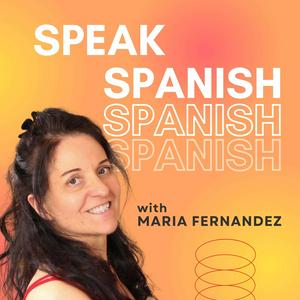Learn Spanish with the Bible - Master verbs, pronunciation, and fluency by diving deep into John 5:24 and unlocking the Bible's power as your ultimate language tool.
🎧 Listen to my free Spanish audiobooks on YouTube, Spotify & moreLearn Spanish fast with my step-by-step courses.EPISODE TRANSCRIPTWhat if one verse from the Bible could help you practise Spanish grammar, pronunciation, and fluency—all in just a few minutes? In today’s episode, I’ll show you how the Bible can become one of your most powerful language-learning tools.We're going to dive into John 5:24, using my Spanish KJV translation. We'll break down this verse the same way we do in my course, 'Learn Spanish with the Bible.' Get ready to transform your Spanish!First, let's hear the verse in both English and Spanish. Listen closely for the sounds and the rhythm.Here's the English:{5:24} Verily, verily, I say unto you, He that heareth my word, and believeth on him that sent me, hath everlasting life, and shall not come into condemnation; but is passed from death unto life.And now, in Spanish:{5:24} En verdad, en verdad os digo, el que oye mi palabra y cree en el que me ha enviado, tiene vida imperecedera; y no entrará en condenación, sino que pasa de muerte a vida.Let’s go through the verse, a few words at a time:Verily, verily, I say unto you,En verdad, en verdad os digo,Notice the verb form ‘digo’. Which verb is it? It’s decir (to say, to tell). And which tense is it?: digo. It’s the present tense. These are the six forms of the verb ‘decir’ in the present tense. Say them after me: digo, dices, dice, decimos, decís, dicen. That’s the verb ‘decir’ (to say, to tell) in the present tense.In this line, ‘en verdad, en verdad os digo’, notice also the pronoun ‘os’. Which person does it refer to? In English this line is ‘verily, verily, I say unto you’ - ‘en verdad, en verdad os digo’. The pronoun ‘os’ refers to ‘vosotros’. ‘Os digo’ ( I say unto you).Now let’s zoom in on the next line—you’ll hear a beautiful example of how vowels work in Spanish.The next line in our verse is: He that heareth my word, - el que oye mi palabraNotice how I say the word ‘palabra’. This word has three A, and the three of them have the same sound: A. The Spanish A always has that sound, whether it comes at the beginning, in the middle, or at the end of a word: A. Palabra.And what about the word ‘oye’? I’ll say the line again: el que oye mi palabra (He that heareth my word).‘Oye’ is a verb form. Do you know which verb it is? It’s the irregular verb ‘oír’ (to hear). ‘Oye’ means ‘he hears’, so it’s the present tense. These are the six forms of the verb ‘oír’ (to hear) in the present tense. Say them after me, out loud. Always say the Spanish words out loud, not just quietly or in your head: oigo, oyes, oye, oímos, oís, oyen.See the full transcript.💌 Sign up to get my free weekly Spanish lessons.🇪🇸 Visit my Spanish learning website.WHO AM I?💃🏻 I’m Maria Fernandez, a native Spanish speaker from Madrid (Spain). I’ve taught Spanish for over 5000 hours, and counting. My mission is to make you fluent in Spanish super fast. Creating step-by-step lessons for you is one of the things I love most. 😀 Over the last few years I've published a bunch of courses, books and audiobooks. I’ve also studied an insane amount of English, French, German, Italian, Portuguese and Japanese. To find out more about me, visit my website: kerapido.comSupport the show


